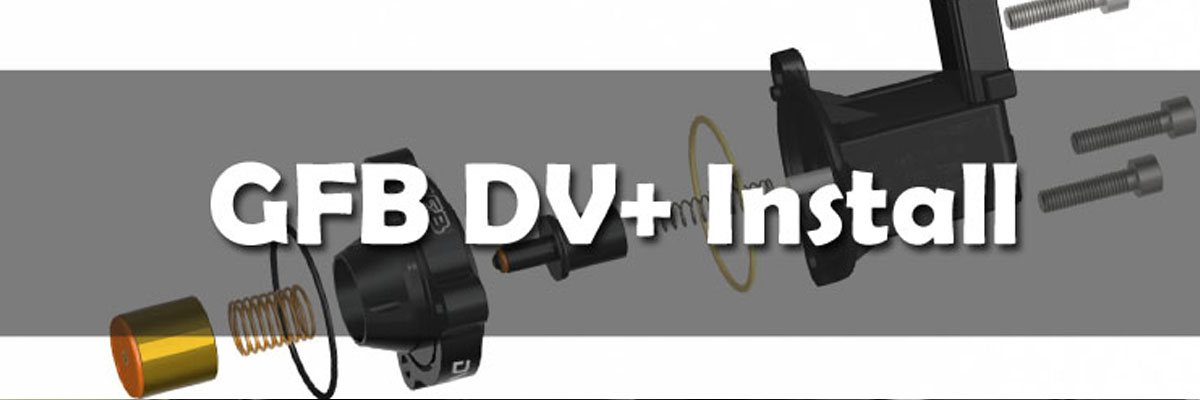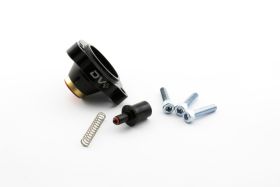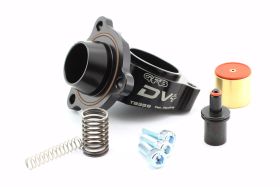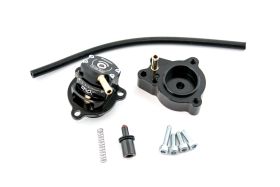GFB DV + Install Guide for 2.0T VW and Audi models


Installation Instructions for GFB DV+ TMS valve (part # T9351)
Here we have a video installing this DV+ on a MK7 GTI, which would be similar on most models
The DV+difference
Whilst the DV+ might look pretty basic,there is a very significant difference in the way it operates compared to the factory diverter valves, and other aftermarket products on the market.
The factory diverter uses the solenoid to directly actuate the valve. The problem with this method is the actuating forces are very weak – the return spring is weak, and the solenoid coil is weak when the valve is fully closed because of the long 5mm stroke (magnetic force diminishes significantly as distance increases). So increasing the spring pre-load of the factory valve doesn't help, since the solenoid coil will have trouble opening the valve.
The GFB DV+ uses the factory solenoid coil, but its role is to control the pressure signal used to actually open and close the piston, which is known as “pilot actuation”. This means the forces that the solenoid coil deals with are much lower, and its operation is therefore reliable at much higher pressure. The solenoid operates a plunger that controls pressure to the back of the piston. When the solenoid is off, there is equal pressure on both sides of the piston, but importantly, the area the pressure acts on is about 25% LARGER on the back of the piston than the front.So there is 25% more force holding the piston shut than there is pushing it open. The bottom line is, it doesn't matter how much boost you run, the DV+will never crack open.
When the solenoid activates, the pressure on the back of the piston is relieved, and it can then open. The benefits of this system are reliable valve actuation at high boost, no leakage, and being all metal parts, no failures due to increased temperature.
Because the DV+ has a higher closing force than opening force, it doesn't actually NEED a return spring behind the piston to work – it will open and shut, and hold boost, just as reliably with or without the spring.
However,using the spring means that unlike the factory diverter, the GFB DV+ will open in response to both boost pressure AND the ECU signal operating the solenoid.That is, if the solenoid is triggered but there is no boost, it won’t open. If the solenoid is triggered and there is boost, the valve will open only as long as there is boost pressure pushing it open. It will close itself as boost pressure in the intercooler drops, even if the ECU is telling it to open. This operation method results in less turbo lag, because the valve is not opened unnecessarily.
This is the basis behind GFB’s TMS principle, which is this; turbo lag is minimized when the valve only vents just enough air to prevent compressor surge – the graph opposite illustrates the reduction in lag. To read more about the TMS principle, visit our website: www.gfb.com.au
This product is intended for racing use only, and it is the owner’s responsibility to be aware of the legalities of fitting this product in his or her state/territory regarding noise, emissions and vehicle modifications. GFB recommends that only qualified motor engineers fit this product.
Materials and workmanship of this product are covered by a lifetime warranty. Moving components subject to wear are covered for a period of one year from the date of purchase. Warranty is limited only to the repair or replacement of GFB products provided they are installed and used as intended, and in accordance with all applicable warnings and limitations. No other warranty is expressed or implied.
GFB products are engineered for best performance,however incorrect use or modification of factory systems may cause damage to or reduce the longevity of the engine or drive train components.
What to expect from your DV+
The DV+ is designed to offer three key improvements over the OE diverter:
Longevity:
The DV+ will outlast any version of the factory diverter. If you've ever replaced a factory diverter, chances are it won’t be your last. Fitting a DV+is good insurance and pays for itself after one or two factory diverter replacements.
Boost holding:
There are a number of revisions of factory diverter valves, each with their shortcomings. The diaphragm types (revision G and early C) typically seal well, until they begin to fail - which is almost assured on a tuned engine. The piston-type revision D and later model C valves are not as fragile, but their ability to seal ranges dramatically from average to terrible, even straight out of the box.
The DV+ will seal properly even up to 35psi, ensuring all of your hard-earned boost gets to the engine. Of course, the performance benefits you notice from the driver’s seat will depend entirely on the condition of the factory diverter you replace. For example, if your factory valve is not (yet)leaking significantly, there will be no change to your peak boost.
However, if your factory diverter is leaking only a small amount, a DV+may show the same peak boost, but with an improvement in the amount of boost held to redline. This is because a small leak is easily overcome by the turbo in the mid-range, but at higher RPM as the turbo runs out of flow, a small leak can lead to a more noticeable drop in boost pressure. In this instance, the DV+will result in less boost drop-off at high RPM.
Finally, if your factory valve is leaking significantly, fitting the DV+will result in higher peak boost pressure, as well as less drop-off at high RPM.
Throttle response:
When using the DV+ with the main spring installed, it will preserve as much boost pressure as possible when the throttle is lifted. This means that when you lift off to shift, or when you balance the car with the throttle mid-corner (using slight on-off-on throttle modulation), the DV+ can help recover boost faster.
What the DV+ can’t do however, is create more boost, or cause the turbo to spool faster. Quite simply, whatever boost the turbo makes, the DV+ will deliver to the engine, and it will also preserve as much boost pressure as possible during a brief throttle lift-off,which is where the faster boost recovery comes from. If there is no boost to preserve, or if boost still drops off at high RPM, that is simply highlighting the limitations of the turbo.
Notes on using the DV+
On some cars, the different operating method of the DV+ that is used to improve throttle response can result in different sounds from the intake at low RPM. This is no cause for alarm, and does not indicate a faulty valve.
Similarly, on some cars it is possible that an ECU fault code P2261 may occur. Again, this is not cause for alarm or an indication of a faulty valve. P2261 is a “soft” code, which does not illuminate the check engine light, nor does it have any adverse effects on the engine. If it does occur, it is simply because the ECU detects that something about the diverter valve operation has changed, which essentially it has - for the better – but the ECU is not able to tell whether diverter valve operation is better or worse, only that it is different from what is expected.
Both of the conditions described above are harmless to the engine and turbo, but if you wish to prevent either from occurring, simply remove the mainspring (the left-most spring in the exploded diagram opposite) from the DV+.This will cause the DV+ to operate like the factory diverter, which will forfeit the benefit of improved throttle response and boost recovery, but it will still offer boost holding and longevity benefits over the factory diverter valve.













Comments